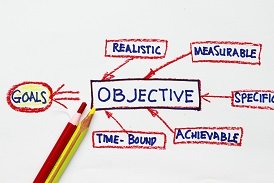- Home
- 7 Steps of Goal Setting
Master Your Dreams: The 7 Steps of Goal Setting for Success
Do you ever feel like you work hard but at the end of the day, (or the week, or the year) and you haven’t got to where you want to be in your life? One reason for this is that you have not spent enough time reflecting on what matters most and then applying formal goal-setting rigor to those thoughts. After all, would you set off on a long journey with no clear idea of destination or purpose? Probably not! Just as we needed a map to navigate where we were going, the same could be said for setting clear goals to guide you on your journey. With clients, I use these 7 Steps of Goal Setting Success:
- Know what truly matters
- Define the results you want to see
- Write these goals down
- Use the 1 3 5 goal-setting framework to break these goals down
- Prioritize and schedule your tasks
- Stay motivated
- Reflect and adjust your goals
Step 1: Know What Truly Matters
Why is this important in the 7 steps of goal setting? Because if it truly matters then the efforts and the time you put into this goal move you towards an outcome that is meaningful and impactful.
 Ask Clarifying Questions
Ask Clarifying QuestionsAsk yourself the following questions
- Why is this goal important to me?
- Does this goal align with my values and beliefs?
- If I achieve this goal, what impact will it have?
- Is it worth the effort? What sacrifices am I willing to make?
- Is this goal aligned with other areas of my life? In other words, does it conflict with other goals in my life? For example, is the career goal I am about to set conflict with a work-life balance goal?
What activities can you do today?
- Conduct a Personal Audit. Taking a wholistic view of your life domains, which areas need improvement, and where do you need to focus your energy. Here's how to conduct a comprehensive personal audit:
- Write down all areas of your life, such as health, finance, career, relationships, etc.
- Rank these different life areas on their importance and current satisfaction.
- Consider your current commitments and where your energy would best be rewarded.
- Core Values Reflection Activity. What values and beliefs are most important to you? Whatever goals you set, they should align with these values and beliefs. For example:
- List your core values (e.g., integrity, security, adventure). Here a list of the common values
- Ensure your goals align with these values.
- Interview Your Future Self. Imagine your life five years from now. What accomplishments do you want to look back on? How do you want to be remembered by your colleagues, friends and family? Write a letter from your future self to your present self, describing what's important and valuable to you.
Step 2: Define Specific, Measurable Goals
Once you've identified areas of focus, it's time to define specific, measurable goals. This second step of the 7 steps of goal setting is crucial because vague goals produce vague results.
The SMART criteria ensure each goal is Specific, Measurable, Achievable, Relevant, and Time-bound.
|
S |
Specific |
When creating a goal you want it to be short and to the point. Consider using action verbs to state your goal. |
|
M |
Measurable |
Measurable goals allow you to track how you are going and review, reward, and re-calibrate. |
|
A |
Achievable |
Having clear action steps and milestones shows you the path to achieving your goals. |
|
R |
Relevant |
Your goal should matter to you and align with other relevant goals. |
|
T |
Timely |
Your goals should be time-bound so that they create a practical sense of urgency. |
This proven strategy brings clarity and attainable targets within your grasp.
Here are some actionable strategies you can take today:
- Set SMART goals: Use our in-depth article on how to set SMART goals with a ready-made fillable PDF template.
- Outcome Visualization: A strategy that has long been part of elite sports, picture what achieving this goal looks like, how it will feel, and what you need to do to get there.
- Goal Anchoring: Attach each goal to a personal value or aspiration to strengthen commitment. (see how this could link to the values exercise)
 Set Goals According to the SMART Criteria
Set Goals According to the SMART CriteriaStep 3: Write Down Your Goals
You've probably heard the tale of the Harvard (or Yale) study where only 3% of graduates had written goals, and 20 years later, they were earning ten times more than their peers. Spoiler alert: it's an urban myth! But don't worry, because real research by Gail Matthews at Dominican University has uncovered the true power of goal setting.
Her findings show that writing goals down significantly increases your chances of achieve them. This can happen for a bunch of reasons. Writing goals down
- Increases Motivation: Putting your goals to paper makes the abstract into the tangible concrete plans.
- Improved Focus: Writing goals down helps you focus on what you need to do (e.g. resources, time, energy) to achieve them.
- Enhanced Memory: When you write down you help encode the information into long-term memory, which makes it easier for you to recall.
- Visualization: Writing down your goals allows you to visualize them more vividly – which is linked to goal success.
What actionable strategies can you do today
- Create a Vision Board: Collect images and words that represent your goals and place them where you see them daily. If your goal is to save money, you might include pictures of what saving could help you achieve—a vacation destination or a new home—on your vision board.
- Goal Journal: Maintain a dedicated notebook where you not only write down your goals but also document progress and thoughts.
- Daily Affirmations: Consider writing your goals affirmations in the present tense. For example, “I am regularly jogging 5 kilometers” reinforces belief in your success.
- Digital Tools: There are plenty of apps to help you maintain a goal journal. I have had clients use Evernote and Notion to name a few. One client even used a digital vision board on Pinterest. She pinned images that reflected her aspirations, such as peaceful nature scenes for a fitness goal and bustling cities for a career-related one.
 Write goals down to achieve them
Write goals down to achieve themStep 4: Break Goals into Manageable Tasks
In the 7 steps of goal setting, breaking your goals into smaller and more manageable tasks is often where I see people get stuck.
Why?
The key is to get granular here. Ask yourself questions like:
- What do I need to do daily?
- What do I need to do weekly?
This granular approach not only makes goals less overwhelming but also easier to use and achieve over time.
For a structure to do this, I really like the 1 3 5 goal setting framework – also known as the Goals, Priorities, and Strategies (GPS).
Here's how it works:
- One Goal: Start by identifying one main goal.
- Three Priorities: Next, determine three key priorities that support your main goal.
- Five Strategies: For each priority, identify five actionable strategies. These strategies are specific steps or actions you need to take to accomplish each priority.
This approach forces you to break down larger tasks into more manageable chunks.
Actionable strategies you can take today include:
- Downloading the 1 3 5 goal setting framework template: This template creates a clear, organized plan that helps you stay focused, prioritize effectively, and take consistent action towards achieving your goals.
- Daily or Weekly Task Lists: Identify small, actionable things you can achieve today or this week that contribute to your larger goal. Put these actions as specific items in your calendar so that you protect the time to do it.
- Sub-goal Structuring: For your goal, list sub-goals that can be achieved within a week or a month. This prevents overwhelm by focusing on immediate actions.
Step 5: Prioritize and Schedule Your Tasks
The fifth step of the 7 steps of goal setting is about prioritizing and scheduling your tasks. As a busy person, your time is precious. Allocate specific time slots—just like you do for meetings—to work on each task. This creates a non-negotiable time for your goals, integrating them naturally into your work-life balance.
What Actionable Strategies Can You Take Today:
- Time Blocking: Allocate specific slots in your calendar dedicated to goal-related activities, treating them like meetings you can't miss.
- Eisenhower Matrix: Divide tasks into four categories: urgent and important, important but not urgent, urgent but not important, not urgent and not important. Focus on important but not urgent tasks, which often get overlooked but are critical to long-term success. Read more about the Eisenhower Matrix.
- Weekly Planning Sessions: Spend 30 minutes each Friday morning planning out and scheduling your time for the following week. I like this as it allows me to negotiate and delegate for future week’s activities, but some people prefer Sunday night.
- Color code your calendar: Color-code tasks based on life areas or importance. Generally, no more than 5-6 categories are optimal for your calendar.
Step 6: Stay Motivated
Motivation ebbs and flows, and it is worth finding ways to keep it alive, whether that is reviewing your progress or celebrating the small milestones and victories.
What actions can you take to stay motivated:
- Find an Accountability Partner: Share your progress with a friend or mentor who can provide encouragement and constructive feedback. I find that this can make a substantial difference, especially when my self-motivation wanes.
- Celebrate Small Wins: Reward yourself for achieving milestone tasks to maintain enthusiasm over the long haul. For example, after a HIIT class I used to treat myself to a takeout coffee at the cafe.
- Visualization Techniques: Regularly visualize yourself achieving your goals, feeling the emotions of accomplishment. This deep mental practice can reinforce your drive. For example, Oprah Winfrey used a vision board to manifest her role in the movie The Color Purple. She visualized herself in the role and eventually landed it, which became a significant milestone in her career.
- Motivation Boards: Create a dedicated physical or virtual space filled with inspirational quotes, progress trackers, and reminders of why your goals matter. Personally, I love motivational goal setting quotes to sustain and motivate me towards my goals.
Step 7: Reflect and Adjust Your Goals
 Reflect and Adjust Your Goals
Reflect and Adjust Your GoalsThe last of the 7 steps of goal setting highlights how life can be unpredictable, and that we need to flex. Goal setting is not about being rigid, but rather about being flexible in a way that ensures your goals serve your growth, not thwart it.
Actionable strategies you can take today:
- Quarterly Reviews: Set aside time every three months to review your goals, assess progress, and determine if your objectives need adjusting. One of the most important filters to use in this review is importance, not urgency.
- Feedback Loops: Seek feedback from peers or mentors. Seek their perspectives and identify any potential blind spots.
Conclusion to the 7 Steps of Goal Setting
I find that these 7 steps of goal setting anchor you on what is truly important and provide a deliberate and flexible strategy for success. By focusing on these steps to goal setting, you cultivate the discipline and resilience needed to not only set ambitious goals but also to see them through to completion.
New! Comments
Have your say about what you just read! Leave me a comment in the box below.